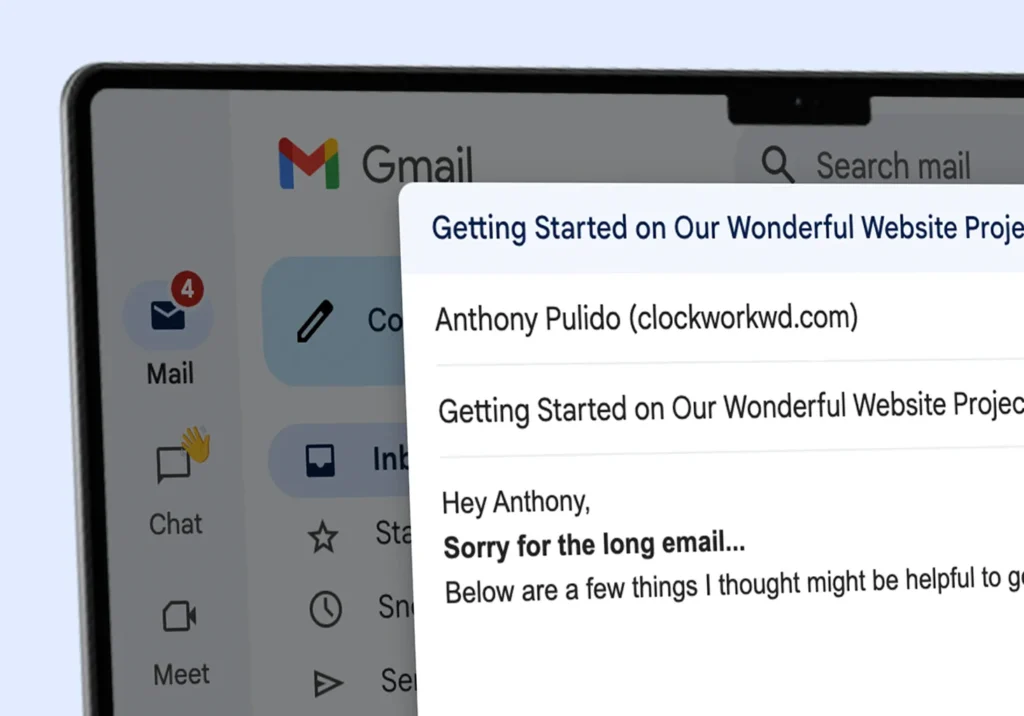After months of planning, design, and development, your new website is finally live. Congratulations! You probably feel a mix of excitement and relief, maybe even a little “what now?” uncertainty. I get it. Almost anyone who’s launched a new website probably does.
The truth is that unlocking your site’s full potential takes ongoing maintenance, strategy, and optimization. That’s why we always prepare clients for what comes after launch – because going live is just the beginning, not the destination.
So what exactly should you focus on first? Let me walk you through seven practical next steps that separate websites that thrive from mostly static sites that just exist.
1. Ongoing SEO: Optimizing for Visibility
“Why isn’t my site showing up on Google yet?” While search engine optimization is an ongoing process, you can start making progress almost immediately with readily available tools.
Here’s a quick win: Your site needs to be properly indexed by search engines before anyone can find it. Use Google Search Console to monitor how search engines are crawling your site and catch any technical issues early. If you’re not sure your site is indexed correctly, just paste the new URL into Search Console to find out.
You also need to make those pages worth finding (for search engines and people). When we worked with SteelMart, their original pages had maybe two sentences of text per page. After adding details about steel products and services, conversions increased 144% across their most important landing pages – with direct calls and direction requests rising the most.
Technical improvements like site speed, mobile optimization, and proper schema markup lay the groundwork for everything else you do with your site. Our professional SEO audit helps you prioritize which fixes will lead to the best results.
2. A/B Testing: Optimizing Through Experimentation
Once people can find your pages in search results, focus on converting those visitors. Even with solid SEO fundamentals in place, your website launch was built on educated guesses about what your customers want. Testing turns those assumptions into actionable insights to act on.
Use tools like Optimizely or Google Optimize to test different call-to-action buttons, landing page layouts, or form designs. Small changes often produce surprising results. Sometimes changing “Submit” to “Get Started” on a form aligns better with the user’s stage in their journey. Other times, moving a testimonial higher on the page builds enough trust to increase inquiries. There’s a lot of psychology behind every well-designed website.
Testing gives you concrete data about what works, but understanding the deeper patterns requires analyzing how users actually behave on your site – which I’ll cover when we talk about analytics and user experience.
3. Maintaining Accessibility and User Experience Standards
Web accessibility standards change regularly, so maintaining compliance is an ongoing responsibility that protects both your users and your business. As Kristen touches on in her recent article about design mistakes to avoid, even basic contrast issues affect over 85% of websites. These issues create barriers for users and potential legal risks for your business.
Run regular accessibility checks using tools and plugins like WAVE, Equalize Digital’s Accessibility Checker, AccessiBe’s AccessScan, or Accessibility Insights for Web. Try to focus on:
- Text that’s hard to read due to poor color contrast (tools above will tell you)
- Missing descriptions for images and unclear page organization
- Form fields without clear labels or instructions
- Buttons and links that are too small to tap easily on phones
These improvements often align with the user experience work you’re already doing through testing, making your site more usable for everyone.
4. Marketing: Expanding Your Reach
With your SEO foundation in place, it’s time to build on those search visibility gains. Our multi-channel digital marketing strategies help amplify the content and optimization work you’re already doing through strategic content marketing.
Content marketing drives both SEO results and audience engagement. Regular blog posts, case studies, or industry insights genuinely help your audience establish your expertise while supporting your search rankings. Once you have quality content, you can find the right channels (social media, email campaigns, or targeted advertising) to reach the right audience where they actually spend their time.
Quality content supports your search visibility, while improved rankings help more people discover that content. This integrated approach creates a cycle that feeds valuable data back into your testing and optimization efforts.
Check out the digital marketing services your favorite Atlanta SEO company now offers.
5. Technical Upkeep: Keeping Everything Running
Even with thorough testing before launch, ongoing technical maintenance keeps your optimized site performing at its best. Those updates also let you work in new feature ideas you get from direct users, and you’ll discover ways to improve the experience as more people use your site.
One of the most critical aspects of maintenance is site speed, which directly impacts both user experience and SEO rankings, especially as your traffic grows. Tools like GTmetrix or Google PageSpeed Insights help you track loading times and spot issues that slow things down. Our hosting and maintenance plans include regular performance optimization because site speed affects both search rankings and conversions.
Beyond speed, regular updates to your content management system, plugins, and security measures prevent bigger problems down the road. All of this maintenance work should include planning for growth by thinking about scalability before you need it.
6. UX & Analytics: Learning From Your Users
Your website visitors tell you what’s working through their behavior, but you need to know how to listen. Your analytics tell you which of your optimization efforts are actually working. Free tools like Google Analytics track conversion rates, traffic patterns, and user journeys through your site. Look for pages with high bounce rates that might need content improvements, or popular pages that could benefit from stronger calls-to-action.
User feedback tools like surveys or feedback widgets provide direct insights from your audience. User behavior tools like Hotjar or FullStory show you how people actually use your site versus how you think they use it. This data might show that nobody scrolls down to see your most important content, or that users are trying to click on elements that aren’t actually clickable.
The information you gather here helps guide your decisions about everything from content strategy to technical improvements. The more you learn from your users, the better you can optimize their experience.
Your Post-Launch Action Plan
Remember, launching a website is just a milestone, not the end-all be-all of your marketing journey. You’ll see the best results when you treat your website as an active business tool rather than a set-it-and-forget-it digital brochure. Here are a few key things we track with our clients:
Monthly priorities:
- Review Google Analytics for pages with high bounce rates or strong conversion opportunities
- Run new URLs through Google Console to force index them
- Check site speed with GTmetrix and fix any performance issues that appear
- Update content management system, plugins, and security measures
- Test one new element (CTA, form, or page layout) based on user behavior data
Quarterly reviews:
- Use accessibility monitoring tools above to catch compliance issues early
- Analyze which digital marketing channels are driving the best traffic and conversions
- Assess whether your content strategy is supporting your business goals
- Plan upcoming features or improvements based on user feedback
Annual planning:
- Run thorough audits for SEO performance and accessibility compliance (we can help!)
- Review hosting and maintenance needs as your traffic grows
- Evaluate whether your digital marketing strategy aligns with business objectives
This ongoing optimization is how you know that your website actively supports your business goals rather than just existing online. The challenge is that coordinating all these systems while running your business takes quite a bit of time and technical know-how.
Getting the Support You Need
If this is all overwhelming, that’s completely normal. Whether you need help with SEO strategy, website care plans, or finding your voice through content planning, having the right team makes the difference between a website that grows your business and one that just hangs out online.
Ready to turn your new website into a growth engine for your business? Let’s talk about how we can help you navigate what comes next.
Frequently Asked Questions About Website Maintenance
How long should I wait before making changes to my new website?
Give your site 2-3 months to collect meaningful data before major changes. Small tweaks based on user feedback are fine, but avoid overhauling elements you just launched before getting a trustworthy sample size. Use Google Analytics to see what’s actually working first.
What should I prioritize in my first month after launch?
Focus on the basics: check that Google Search Console shows no crawl errors, monitor site speed with tools like GTmetrix, and start collecting user behavior data. Technical elements like schema markup help search engines understand your content. An SEO audit can catch issues early.
Do I really need monthly website updates?
You can’t set it and forget it if you want results. Monthly CMS, plugin, and security updates are essential for performance and safety. Regular content and performance monitoring keep you competitive. Our website care plans explain why proactive maintenance is worth the investment to avoid bigger problems.
Do you work with all types of businesses and organizations?
We work with everything from boutique businesses to large enterprises and nonprofits. Our portfolio includes e-commerce sites like All Around Industry Supply, major educational platforms like the Georgia Department of Education, smaller orgs like Team Novo Nordisk, and many others. Each project gets the same attention to detail, whether it’s a simple brochure site or a full-blown enterprise platform.
Should I handle optimization myself or hire professionals?
Basic content updates are manageable in-house. Technical SEO, accessibility compliance, and performance optimization often need specialized knowledge. Many businesses try to handle daily content while partnering with experts for technical aspects (with mixed results).
We can help with all of that.




